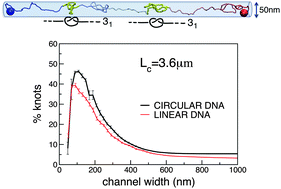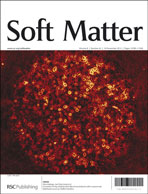Knotting and metric scaling properties of DNA confined in nano-channels: a Monte Carlo study
Abstract
We report on a numerical study of the equilibrium metric scaling features and knotting properties of linear and circular model DNA chains inside cylindrical channels. The model chains are 1.2–4.8 μm long and the channels are 30–1500 nm wide. The metric scaling behaviour of confined circular chains is shown to follow the de Gennes regime down to channel widths of ∼85 nm, analogously to the well-studied case of open chains. A notable fact is that the same channel width (85 nm) is associated with a maximum incidence of knots in both linear and circularised chains regardless of their contour lengths. This coincidence suggests that topology-based features could aid the challenging characterization of the metric crossover behaviour. Finally, it is shown that compared to slits and cavities, channels are the confining geometry where chains have the largest probability to be tied in simple knot types. The strong width-dependent knotting probability and the abundance of simple knots suggest that nano-fluidic devices based on nano-channels could be ideally suited for producing DNA molecules that are preferentially tied in simple knots for sieving molecules based on their knotted state.


 Please wait while we load your content...
Please wait while we load your content...